#ttte midlander
Explore tagged Tumblr posts
Text
The Talyllyn always gives their engines a good healthy diet to keep them fit and thin! Just take it from No.6!

Translation cuz it’s all chicken scratch: “Hm? O-Oh! A-Ah’m fine, M-Midlander! S-S-Starvin’, and sad, b-but fine!


Translation from chicken scratch: “W-Well, starvin’ i-is a strong w-word, ah suppose! But the thing is the manager wants us fit and healthy, s-so he’s p-put us on a-a vegan diet!”
“S-Sure! Ah feel ah b-bit ch-chilly, s-sometimes ah feel weak and my fur is f-fallin’ out, b-but ah’m doin’ g-great!”
#thomas and friends#thomas the tank engine#monster engines#ttte douglas#douglas the shy engine#ttte midlander#ttte narrow guage engines#ttte Talyllyn railway
54 notes
·
View notes
Text
Random meme I had play in my head from a short I just watched
Sir Haydn: we're going on a trip
Falcon/Sir Handel: in our favorite piece of shit
Peter Sam: doing 95
The rest of the TR and SKR crew: we're gonna fucking die
But the SKR and the TR crew
#ttte#thomas and friends#duckyspeaks#ttte skarloey#ttte memes#ttte rusty#ttte rheneas#ttte sir handel#ttte peter sam#ttte duke#ttte duncan#ttte smudger#ttte bertram#ttte talyllyn#ttte sir Haydn#ttte Edward Thomas#ttte midlander#ttte mighty mac#ttte Freddie#ttte dolgoch
11 notes
·
View notes
Text
Okay

So like half of this is TTTE related and then just Jackson storm
Tagging:
@thefluffyrailway-official and @septemberofgenders
lets play a game
what comes up in your tags when you types
bo
mi
ca
pe
ga
21K notes
·
View notes
Text


Saw this meme going on about and had to join in, it fits them so well
Bonus: some alternative rws Duncan pic icon concepts & the og:



#ttte#ttte rusty#ttte duncan#rusty the little diesel#rusty ttte#duncan ttte#rws#railway series#the railway series#thomas and friends#my art#my art <3#my art stuff#digital art#my artwork#procreate#my artwrok#my art blog#my art tag#my art style#might do one with Gordon and Rebecca and duke and Nia this meme fits so many hahaha#got mainly inspired and based off of fandøm_ärts take of them on their yt channel tried doing rusty in a combo of midlander
209 notes
·
View notes
Text

🚂 Day 13 - Leaves 🌿
Taking your secret crush best friend in a siding by the lake in a lovely spring day
#thomas and friends#ttte oc#traintober#ttte traintober#traintober 2024#FSA Locomotives#Aubrey the Radial Tank#Claude the Midlander#train#pixel art
119 notes
·
View notes
Text
Douglander (Midlander x Douglas)

There’s Rusty x Duncan Going On. Soooo….
Talyllyn Ruscan :3 💚🩵
#ttte#ttte humanized#douglas#midlander#talyllyn railway#narrow gauge#narrow gauge engines#thomas and friends#otp ship#otp shipping#otp
24 notes
·
View notes
Text
What is the 'Engine Rulebook' and where did it come from?:
So, this really early era of railways was a bit insane, and I am not quite well-versed enough to make a case-study out of everything - but like with my Big 4 scrap post, this is more about trends than singular examples - though some do appear.
The 'Engine Rulebook' is basically the set of rules that every engine ever is taught when built. It's a series of important rules, customs and doctrine used by managers to keep engines in line. Yes, I will use a little business-management theory in here, because early management styles have a major effect. And every railway has its own rulebook that may have differences. But there are a few key things in the 'Engine Rulebook' that I see being universal:
1: The company comes first. This is basically the company ensuring loyalty by indoctrinating the engine to see its railway company as the most important aspect of their life. In the Railway Series, Donald and Douglas have very strong ties back to Scotland and the Caledonian railway - which is why they enjoy blue so much. It's the Caledonian Railway colour! And then there's Duck - who literally continues to wear his GWR colours even after joining the NWR. He's deeply connected to the GWR because of this loyalty taught to him.

2: Railway rules. This includes signalling, signage, speed limits, whistles and their uses, headcodes, flags and every other piece of railway rules. They are read the rulebook, and learn everything in it. It's vital! Percy is an industrial engine who is never taught this rulebook - because industries don't have many engines and often pilfer bits from a bigger company's - and thus Percy doesn't know much about the rules of being on a railway when he arrives on Sodor.

3: Etiquette (based on duty). Now, I don't mean bowing or curtseying or the proper fork for fish - I mean the ins and outs of the duty the engine will be expected to complete. Passenger engines learn how to handle coaches and speak politely to passengers, freight engines learn how to handle trucks and look after different cargos, shunting engines learn a new set of rules for the yards - this sort of thing. Gordon struggles with trucks because he was never taught how to handle them.
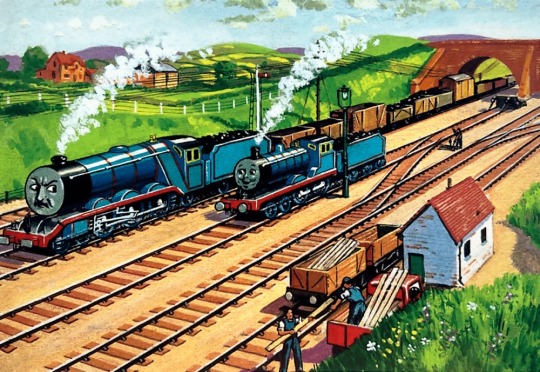
4: The managers are always right. Touched on this in a reblog of this @mean-scarlet-deceiver ramble, but its basically that the engines are taught that their managers are right in all contexts (unless breaking one of the above rules) and need to be respected and have all directions followed. The manager says to shunt - you go and shunt. They say to go get scrapped - and a good engine listens without hesitation. Doesn't work out in real life all the time - see Oliver, or the Big Engines' strike - but it definitely keeps most engines in line.
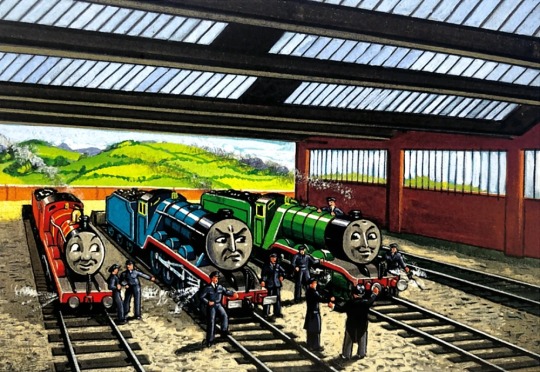
So we have these four core rules - but where did they come from? Well...
Regency Era Railways:
Straight off the bat - this is the era where every railway is figuring itself out. The L&MR was where everything was forged in fire - before it, the only railways that existed were isolated plateways in mines and the Stockton & Darlington Railway. None of these were anywhere near as complex as the L&MR, which is really the first railway 'system' in the way we might understand today. It's also where the first sentient engines begin to make a proper appearance and have an effect on people. Before, they were hidden in mines, if they existed at all - but now the public can see them!

Like, imagine this rocks up to collect you in an era when the most advanced method of transport is literally a horse. And it has a face. Remember, in this period people though that if they went over a certain speed or through a tunnel they would explode - so now the thing that might just kill them has a face?!
Managers would very quickly begin implementing ways to soothe their passengers. One way of doing that would be to dehumanise the engines - I can see many early engines being given basically no education because they are both seen as being 'working class' and because they are machines. When Rocket first ran, there were no public schools.
In this era, engines didn't know much, and they were isolated on their little systems. Yard managers are one of the few people with authority that these engines meet on a regular basis, and they use this to their advantage and cultivate this idea that the engines are entirely subservient to them. This is where that manager loyalty begins to become apparent - just not quite in its modern form.
The only education an engine would get is how to be loyal. Why should they learn signals, or passenger etiquette, or how to read? That is a driver or a guard's job. And so this really early era is characterised by dehumanisation and a lot of public-relations officers doing their best to downgrade the sentience of the engines. It's a lot of "yes they have a face, no they don't have intelligence, don't worry". This does extend into the Victorian era, as seen in Very Old Engines, as Skarloey arrives on Sodor with some principles taught at the workshop, only to be met with "you don't have rights, do your job." Which he naturally rebels at and then gets covered in a tarp for his troubles.
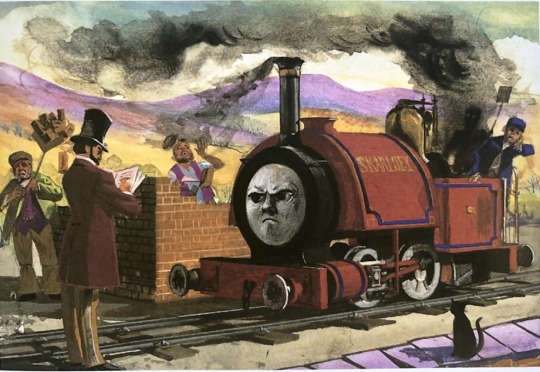
Of course, the Regency Era ends very soon into railway history, and just in time for a major game-changer.
The Victorian Era:
1838 is the year the first GWR train runs, and this railway in the South-west of England will have a huge impact on all railways that come after. First, the entire board of directors are very elitist and influential in parliament. This is a railway that needs to live up to its owners.
It is the GWR, not the L&MR, that writes the first book on engine learning. It's also the GWR, and not any other railway in the UK, that first develops a proper corporate culture for its engines that they actually like. The GWR does this by actually treating the engines like they have sentience.
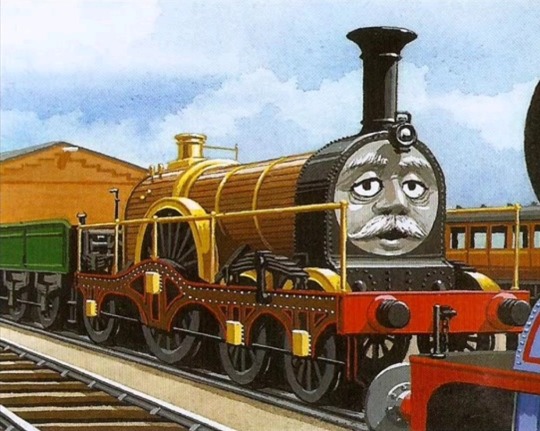
Engines like Iron Duke are introduced to the 'Great Western Way' - this being the rulebook that Brunel and Gooch develop to best serve their wealthy owners. These engines are taught to read, understand the rules of the railway, passenger etiquette - which by now can be taught because there's less fumbling around blindly - and perhaps most importantly: they are taught a very proud mindset. The railway is the most important aspect of their lives, and they are to serve it to the best of their ability. All four of the rules appear in their first form here, except that the etiquette is not entirely based on duty, and instead all engines are taught all jobs - which horrified much of the rest of the railway companies.
But while this is going on on the GWR, the rest of the country's railways were trying to survive a crisis. Railway Mania swept Britain, and hundreds of engines and built (and destroyed) by the week. One thousand bills for new railways were submitted to parliament during this period, and while not all were built - it certainly had an impact. The LNWR was formed during this period, chunks of the Midland Railway, NER, GNR, GCR, Caledonian and basically every other major railway were all constructed in this time frame - but that didn't mean a drastic improvement in how the engines were treated in this area. Many North-western railways were influenced by the thinking from the L&MR, leading to entire fleets of early engines having zero clue how to act or even speak in some cases. When the bubble collapsed, many engines were scrapped - and this is where the other extremely important pillar stone of railway doctrine was introduced: engines are expendable, and should not want to hinder a company. The fourth rule is set into stone here, and goes unchanged and practically unchallenged all the way into the modern era.

This here, the end of steam in Britain, is able to happen because of principles introduced during Railway Mania. British Railways uses this rulebook and the laws that most likely surround it by this point to justify their actions, and also because thanks to this rulebook very few engines have the vague notion or idea to protest. Why would they, it goes against the rules!
The eradication of steam is almost directly caused by the era of Railway Mania and the principles managers introduced in the era to protect their profit margins. Without that doctrine, engines would have had a lot more rights and a lot more ability to protest being scrapped.
In other words, the 1840's was when scrapping began to appear properly, as well as the explosions, derailments and every other crash from the previous generation. Engines became unfeeling in this era - in the north at least. The GWR escaped this by being... well, not an economic bubble.
However, as the British Isles emerges from Railway Mania, two very strong railways vie for influence: the LNWR and the GWR. The LNWR has that traditional L&MR mindset - and it leads to a huge problem. The engines begin to learn how to speak from their crews, and moreover they question why their GWR counterparts are treated so much better. The LNWR also suffers from a number of easily preventable accidents caused by the engine having zero clue what to do.
Some railways land between the two, and it was the GNR that ended up formulating the four rules in their next evolution: engines were only taught their jobs. This was the GNR compromise with their board members. The board wanted a GWR approach, however the actual managers on the ground rebelled, worrying this would lead to the engines working together to demand fairer treatment. The Communist Manifesto was in major circulation at the time, and none of these companies wanted their engines getting any ideas. Instead, they implemented something of a class system, with express engines at the top and shunters at the bottom.
In the TVS, Emily is extremely abrasive towards Thomas (Seasons 8-12), and it may just have to do with the way she was raised, seeing shunters as the lowest form of engine. Gordon certainly did!

These three very distinct practices all melded and fused together on the Midland Railway - which of course ran right in between them all. The Midland Railway wrote the third proper rulebook in 1859, roughly twenty years after the GWR wrote its.
The Midland Railway's rulebook took the LNWR idea that engines needed to be taught to accept death, the GNR idea of a class system and the GWR importance of company loyalty and railway-rule-knowledge and fused them together, being able to create the rulebook that most British railways would use by 1890. The major exception to this was of course the Great Western, which slowly evolved its rulebook to use the LNWR ideas of engines being subservient to their managers while retaining the classless form of etiquette the engines were taught. The GNR would also hold out on some ideas from the GWR until it was amalgamated into the LNER, due to rising fears of Communism by the board.
Many smaller railways, such as the Furness Railway or the Highland Railway in Scotland, would use the GWR style, due to the smaller size of the workforce, and thus the potential necessity for engines to complete duties they were trained for.
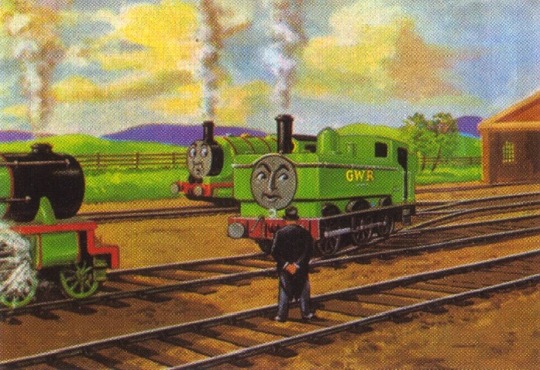
Duck fits into his role at Tidmouth with such ease because he knows the theory behind every express train, every freight train, every style of shunting and branchline service. He doesn't need them, but the GWR engines were taught this just in case. Duck is excellent at his job, but he won't take any flak from the other engines because his GWR ideology makes him see them all as equal. This is of course part of the Great Western Way as explained in this post.
In direct contrast, Gordon has zero clue how to pull a freight train, and stalls on the hill because he physically doesn't know what to do.
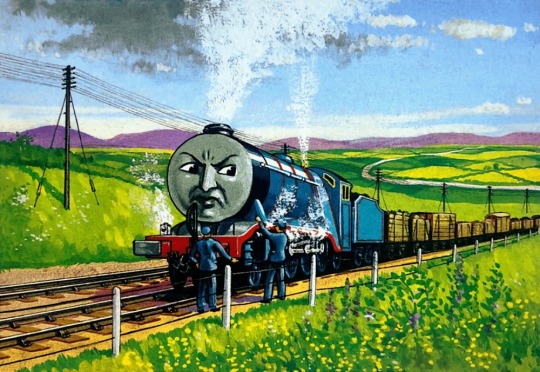
And this brings me quite neatly to Sir Topham Hatt I. See, this is a GWR man who runs a railway that is very heavily influenced by the Midland Railway rulebook ideology. Edward knows how to do multiple tasks because the Furness Railway used GWR practice (maybe that's why he likes Edward?) while none of the other engines do. Sir Topham Hatt's management style using GWR practice is so confusing to them. Why is James - who is mixed-traffic at best - pulling the express? Why is Gordon pulling freight? Why are the big engines shunting?!

And then we have Henry. Sir Topham and Henry have such a rocky relationship, and it in many ways comes from the fact that Henry had none of the formal education that I just discussed. He's a privately-built engine from stolen plans sold cheap. He doesn't actually know the etiquette of a passenger train - no wonder he stops when he doesn't like the weather! He doesn't physically know better, and so he's acting on his first instincts. This clashes so badly with the GWR style which places etiquette almost above everything else. Hatt reacts so badly and outright insanely to this because to him, Henry is actively and deliberately breaking every rule in the book because of his paint? And Henry doesn't have a clue. Look at how horrified he is!
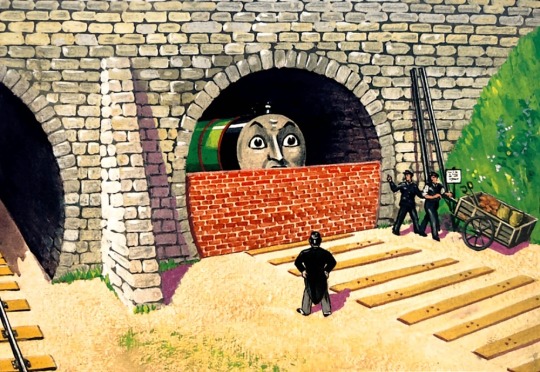
And don't get me wrong, this is extremely unethical and very stupid, but it has a precedence in miscommunication, differing ideologies and Henry's foolishness.
This was another massive ramble with a lot of insanity, but I do enjoy writing these. Helps organise my mind! As usual, none of the above pictures belong to me, and feel free to chuck in a comment with your opinion!
#the 1800s#ttte edward#i need to calm down#thomas the tank engine#railway series#railways#real life railway#what are the rules for trains?#fanfiction writer#ao3 stuff#british rail#british railways#Great Northern Railway#gwr#Midland railway#LNWR#ttte au#sir topham hatt#ttte henry#ttte gordon#ttte skarloey#ttte duck#ttte emily#weirdo shit#long reads#very long post#britain#Great Western way
131 notes
·
View notes
Text


introducing the big four. the main troublemakers. berwyn (GWR) is probably the only one who still has this photo.
ask box is now open as well !
#inbetweenthelines#ibttl4#lner#lms#southern railway#gwr#great western railway#london midland scottish railway#london north eastern railway#ttte#the railway series#railway series#personification#gijinka#thomas the tank engine#thomas and friends#railway#british rail#oc art#digital art
42 notes
·
View notes
Photo
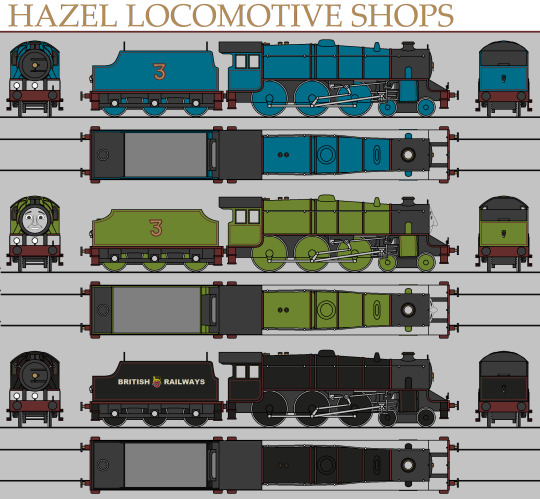
Henry, aka the LMS Black 5...who needs an update. Also I need to do more LMS engines.
15 notes
·
View notes
Text

Here’s the red engine himself who tried to push Henry out of the tunnel!

#the railway series#thomas the tank engine#thomas and friends#ttte au#the railway series au#the sudrians#winston the midland engine#the red engine
9 notes
·
View notes
Text
I would add Idris (who is a line press machine (at least that's what I think she is)) but Tumblr only allows 10 options and I'm pretty sure nobody outside of select Talyllyn members know that they named a line press machine "Idris". The Talyllyn Railway names practically everything by the way, we're slightly mad (I say that as a life member of the railway).
BTW when this poll ends I will be in Wales, probably pestering some Talyllyn members who are close in age to me or being asked to take photos of some random tourists or running around Nant Gwernol with a child who pestered me while on the ride up in the coaches (like last year).
#rheilffordd talyllyn#talyllyn railway#talyllyn#dolgoch#sir haydn#edward thomas#midlander#douglas#tom rolt#alf#trwcwyn & st cadfan#toby#skarloey railway#ttte skarloey#ttte rheneas#ttte sir handel#ttte peter sam#ttte rusty#ttte duncan#ivo hugh
3 notes
·
View notes
Text
Following up on my Douglas and Midlander post;
A Narrow guage engine's diet consists of coal and meat of any kind. The coal keeps up their energy, and the meat keeps them healthy and fat. Unlike humans, being fat is actually good for a NG engine. It keeps their fireboxes lit longer, helps their fur and keeps them strong.
Narrow gauge diesel diets consist of vegetation of any kind (moss, grass, weeds, etc) and they can drink diesel fuel. Occasionally, they do eat rodents.
#thomas and friends#thomas the tank engine#monster engines#ttte narrow guage engines#talyllyn railway#ttte midlander
29 notes
·
View notes
Text
Traintober day 12: Teamwork
Based on this video
youtube
It's the Heritage Weekend and the engines were buzzing and chatting as they were both excited and nervous, Tal-y-llyn had not long celebrated her 160th birthday so she was a bit tired. She rolled out of her shed and she yawned before looking around, as much as she liked visitors you can imagine her scare when she had a camera flash go off in her face. Tal-y-llyn squeaked as the flash had upset her, Sir Haydn pulled forward and protected Tal from unwanted and non consensual photographs. Tal thanked Sir Haydn before she set off to go find Dolgoch.
Tal-y-llyn stopped in front of Edward Thomas and asked the Tattoo if he'd seen her sister and best friend, Edward Thomas looked down at his buffers before answering that he had not. Taly sighed before setting off once more, She asked Midlander if they'd seen Dolgoch to which she said that Dolgoch was waiting for her at the top station as they were assigned to double head a vintage train. Talys interest piqued as she made her way to meet her sister.
Once she met up with her sister she was quickly turned around so she'd be in front of her sister and best friend, the two sisters laughed and chattered as they felt like they went back in time to when they were younger and the railway was still brand new. I mean don't get them wrong they do enjoy how much everything has grown and changed but its nice to reminisce on the past.
#duckyspeaks#ttte#thomas and friends#ttte talyllyn#ttte dolgoch#ttte sir haydn#ttte midlander#talyllyn railway#Youtube
4 notes
·
View notes
Text

Confessing a cursed headcanon cus idk where else to get this out
Sometimes I see Emily as a Midland Railway Johnson 0-4-4 (one of the 1890s classes). I’m fine with her being a Stirling single but sometimes this enters my brain for no reason and it feels like it works even tho it shouldn’t. Maybe it’d even look nice in emerald green.
H E L P
2 notes
·
View notes
Text
🚂🛤️


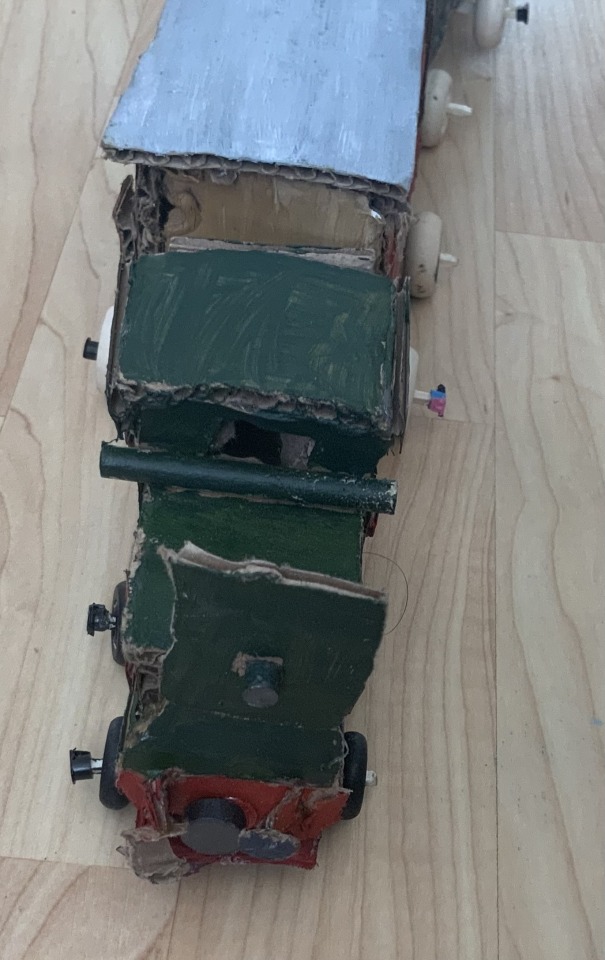
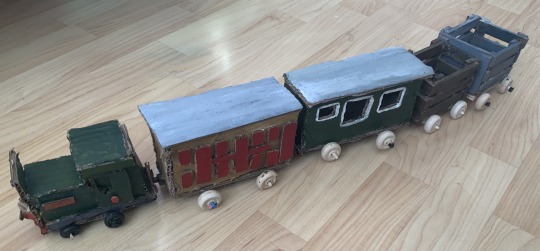
Some Midlander and coaches and trucks I did for my final project at Sculpture I did last week, everyone loved it, someone even took photos it’s was worth the wheels constantly breaking off-
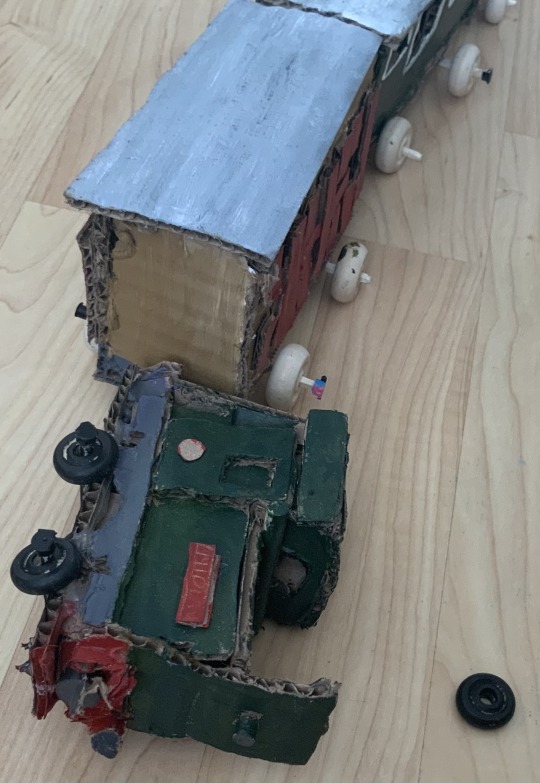
Bonus: oops it looks like Midlander had a bit of an accident-
#my art#my art <3#my art stuff#my artwork#my artwrok#midlander#talyllyn railway#trains#made it from cardboard and paint and used excto knife and got wheels and stick to make them move about#the wheels and sticks kept falling off so I used beads to keep them in piece but yeah i found out my classmate who’s a dad took photos of i#Cause his kids like Thomas and my heart melted the trucks were bulit from scratch from woood and hot glue using ttte references for the#Model coaches same goes with a blueprint for midlander
45 notes
·
View notes
Text

Day 8 - Impact 🚂🚂
Wanted to go with something light for this prompt, so why not just a little buffer bump between lovers?
Their liveries are in fact blue, but I wanted to go with a pallette that reminded of old photographs as to exemplify their long lasting relationship and being both 19th century locomotives
#a little lazy from my part sorry#had little time for this#traintober#traintober 2024#ttte traintober#thomas and friends#FSA Locomotives#ttte oc#train oc#pixel art#gay trains in their habitat#Claude the Midlander#Aubrey the Radial Tank
53 notes
·
View notes